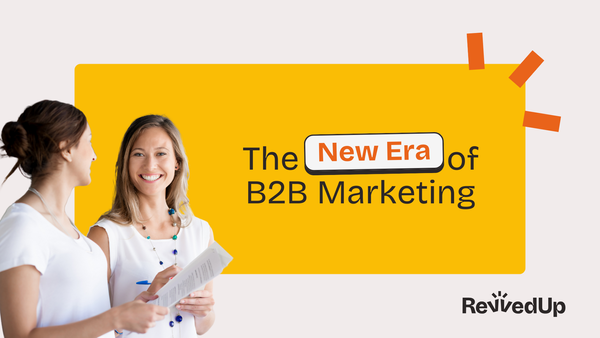The New B2B Marketing Playbook: How AI and Automation Are Redefining the VP Marketing Role

In the fast-evolving landscape of B2B marketing, the role of the VP Marketing has never been more pivotal—or more complex.
As we progress through 2025, marketing leaders are under increasing pressure to deliver qualified pipeline, demonstrate clear ROI, and orchestrate seamless collaboration between marketing and sales.
At the same time, they must navigate a rapidly changing environment shaped by digital transformation, data privacy regulations, and a growing demand for personalization at scale.
If you're a senior marketing leader, understanding these shifts—and how to harness them—will be critical to your success in the months and years ahead.
1. AI-Driven Marketing and Automation
Artificial Intelligence (AI) is no longer a futuristic buzzword: it's the engine driving today's most effective B2B marketing strategies.
AI-powered tools are enabling predictive analytics, hyper-personalized outreach, and automated lead generation at unprecedented speed and scale.
According to recent industry analysis, organizations leveraging AI in their marketing processes have accelerated pipeline progression by over 200% and seen significant improvements in campaign efficiency.
For the VP Marketing, this means the ability to target high-value accounts with tailored messaging—without the manual labor that previously bogged down teams.
AI chatbots, dynamic website personalization, and real-time engagement tools are now table stakes for any organization seeking to stay ahead.
2. The Rise of Hyper-Personalization and ABM 2.0
Generic, one-size-fits-all campaigns are rapidly becoming obsolete.
Today's B2B buyers expect personalized experiences from the very first touchpoint—mirroring their expectations as consumers.
This has propelled Account-Based Marketing (ABM) into a new phase, where personalization is not just a differentiator, but a requirement.
Modern ABM strategies, powered by AI and advanced data analytics, enable marketers to:
- Craft tailored content for specific accounts and personas
- Deliver real-time adjustments based on behavioral and intent data
- Improve customer engagement and re-engagement rates by up to 50%
3. Data Privacy, First-Party Data, and Trust
With the demise of third-party cookies and the tightening of global privacy regulations, the way marketers collect and use data is undergoing a seismic shift.
First-party data—information gathered directly from your own interactions with prospects—is now the gold standard for personalization and targeting.
To succeed, VP Marketing leaders must prioritize:
- Building robust owned ecosystems (resource hubs, communities)
- Implementing consent-based marketing practices
- Leveraging privacy-centric analytics tools
4. Doing More with Less: The Lean Marketing Mandate
Budget constraints and limited resources are now the norm for many B2B marketing teams.
Yet, expectations for pipeline growth and measurable impact continue to rise.
The most successful teams are those who:
- Invest in scalable, automated platforms to streamline ABM execution
- Repurpose assets creatively across multiple channels
- Focus efforts on high-impact accounts, reducing wasteful spend
The Human Element: Leadership, Collaboration, and Change Management
While technology is transforming what's possible, the human side of marketing leadership remains as important as ever.
Senior marketers must foster collaboration across teams, champion data-driven decision making, and inspire their organizations to embrace innovation.
The best leaders are those who:
- Use clear, engaging communication to align stakeholders
- Recognize and celebrate achievements to build momentum
- Create a culture of continuous improvement and learning
How AI-Powered ABM Platforms Enable the Future of Marketing Leadership
So, what does all this mean for the modern VP Marketing? In a word: opportunity.
By leveraging AI-driven ABM platforms, leaders can:
- Automate research and campaign setup: Save hours each week by letting technology handle prospect research, content creation, and outreach logistics.
- Deliver hyper-personalized messaging at scale: Engage each target account with content and landing pages tailored to their specific needs and challenges.
- Accelerate pipeline generation: Focus your team's energy on qualified conversations and deal progression, not manual data entry or copywriting.
- Prove and measure ROI: Gain clear visibility into which campaigns and channels are driving results, supporting data-driven budget allocation and performance reviews.
- Stay agile and future-ready: Adopt tools that can be implemented quickly (often in weeks, not months) and scale as your team and targets grow.
The benefits from organizations that have embraced these platforms consistently report:
- Increases in qualified prospect activity and conversion rates
- Substantial time savings (up to 30% of the week for sales and marketing reps)
- Easier access to enterprise accounts previously out of reach
- Clear, measurable ROI that underpins ongoing investment
Looking Ahead: The Marketing Leader's Roadmap for 2025 and Beyond
The convergence of AI, automation, data privacy, and lean operations is reshaping what it means to be a VP Marketing in B2B.
The leaders who thrive will be those who:
- Embrace AI-powered tools to drive efficiency and personalization
- Align closely with sales to deliver unified, high-impact ABM
- Build trust with prospects through transparent, privacy-first practices
- Foster a culture of learning, agility, and collaboration
As you chart your course for the rest of 2025 and beyond, consider where your team can automate the mundane, personalize the meaningful, and measure what matters most.
The future of B2B marketing leadership is here—and it's powered by AI, driven by data, and guided by human insight.




